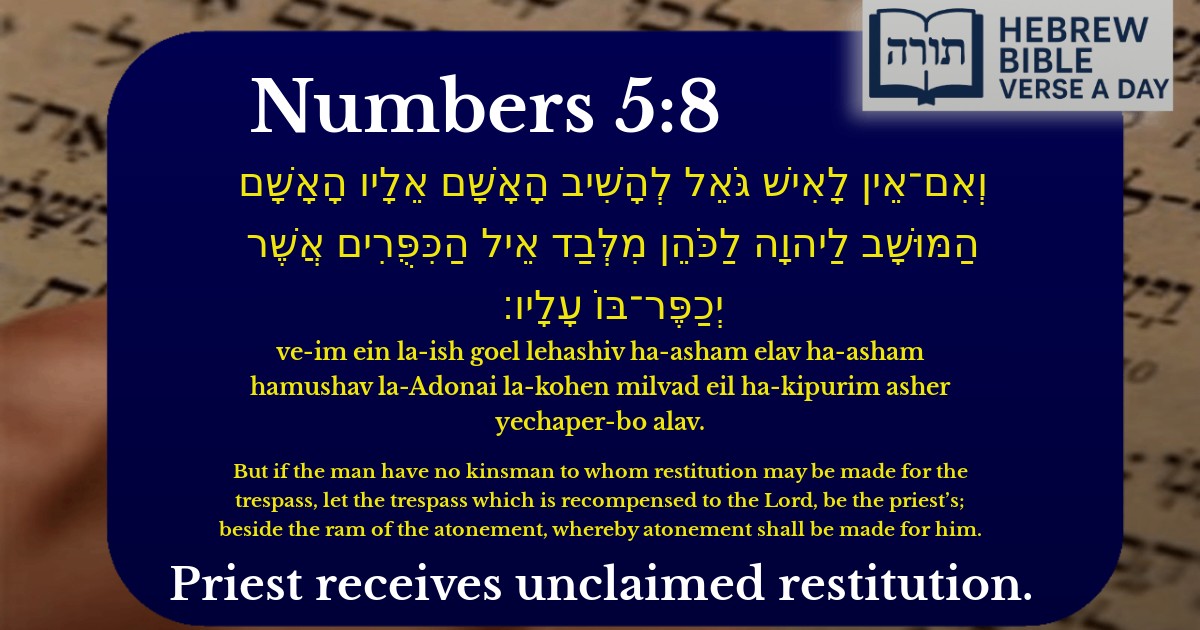Join Our Newsletter To Be Informed When New Videos Are Posted
Join the thousands of fellow Studends who rely on our videos to learn how to read the bible in Hebrew for free!
Hebrew Text
וְאִם־אֵין לָאִישׁ גֹּאֵל לְהָשִׁיב הָאָשָׁם אֵלָיו הָאָשָׁם הַמּוּשָׁב לַיהוָה לַכֹּהֵן מִלְּבַד אֵיל הַכִּפֻּרִים אֲשֶׁר יְכַפֶּר־בּוֹ עָלָיו׃
English Translation
But if the man have no kinsman to whom restitution may be made for the trespass, let the trespass which is recompensed to the Lord, be the priest’s; beside the ram of the atonement, whereby atonement shall be made for him.
Transliteration
Ve-im ein la-ish goel lehashiv ha-asham elav ha-asham hamushav la-Adonai la-kohen milvad eil ha-kipurim asher yechaper-bo alav.
Hebrew Leining Text
וְאִם־אֵ֨ין לָאִ֜ישׁ גֹּאֵ֗ל לְהָשִׁ֤יב הָאָשָׁם֙ אֵלָ֔יו הָאָשָׁ֛ם הַמּוּשָׁ֥ב לַיהֹוָ֖ה לַכֹּהֵ֑ן מִלְּבַ֗ד אֵ֚יל הַכִּפֻּרִ֔ים אֲשֶׁ֥ר יְכַפֶּר־בּ֖וֹ עָלָֽיו׃
Parasha Commentary
📚 Talmud Citations
This verse is quoted in the Talmud.
📖 Kritot 26b
The verse is discussed in the context of the laws of guilt offerings (asham) and the role of the priest when there is no kinsman to receive restitution.
📖 Temurah 5b
The verse is referenced in a discussion about the sanctity of offerings and the conditions under which they are transferred to the priest.


Context of the Verse
This verse (Vayikra 5:13) appears in the context of the laws of asham (guilt offerings), specifically addressing a case where an individual commits a trespass against sacred property but lacks a living relative (go'el) to whom restitution can be made. The Torah outlines the procedure for atonement in such a situation.
Explanation of Key Terms
Halachic Implications
The Talmud (Keritot 11a) discusses this verse in the context of who qualifies as a go'el and when the restitution defaults to the kohanim. The Mishneh LaMelech (commentary on Rambam) notes that this law emphasizes that atonement is not complete until both the offering and restitution are made, even if no relative is available to receive it.
Spiritual Message
The Kli Yakar highlights that this verse teaches the importance of rectifying wrongs, even when no human claimant exists. The restitution given to the kohanim symbolizes that all sins ultimately require reconciliation with Hashem. The separation between the ram of atonement and the monetary asham underscores that repentance involves both spiritual and material repair.